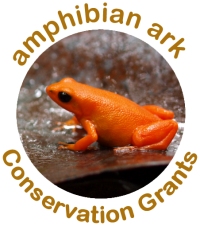
AArk’s competitive Conservation Grants are designed to fund small start-up projects that are in need of seed money in order to build successful long-term programs that attract larger funding. More information about the grants can be found on the Conservation Grants page, and all past grant recipients can be seen on the Conservation Grant Winners page. We’re very excited to announce four projects that were awarded 2019 conservation grant winners. We look forward to seeing great progress and success for these programs. The recipients of grants in 2019 are:
- Using radio-telemetry to track survival and disease outcomes in the Mountain Yellow-legged Frog (Rana muscosa) to inform ex situ management, Tali Hammond, Institute for Conservation Research, USA
- Project Palaka, Phase II – Platymantis insulatus ex situ program, Norman Greenhawk, Project Palaka, Philippines
- First steps towards the conservation of the Darwin’s Blackish Toad (Melanophryniscus nigricans), Igor Berkunsky, National University of the Centre of Buenos Aires Province, Argentina
- Start-up grant for the Lake Patzcuaro Salamander (Ambystoma dumerilii), Margarita Ruiz Flores, Zacango Ecological Park – CEPANAF, Mexico
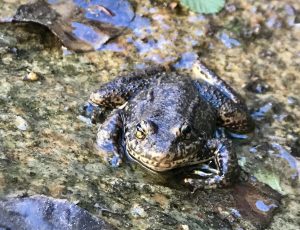 Using radio-telemetry to track survival and disease outcomes in the Mountain Yellow-legged Frog (Rana muscosa) to inform ex situ management
Using radio-telemetry to track survival and disease outcomes in the Mountain Yellow-legged Frog (Rana muscosa) to inform ex situ management
Tali Hammond, Institute for Conservation Research, USA
The Mountain Yellow-legged Frog (Rana muscosa) is an IUCN Red List, federal, and state Endangered species, native to central and southern California. Declines of Mountain Yellow-legged Frogs in the mid-20th century were primarily caused by habitat loss, invasive species, and disease. One of the main conservation challenges currently faced by this species is the small number of remaining populations, all of which are impacted by chytrid fungus and are subject to continued anthropogenic impacts (e.g. climate change induced extreme weather events, habitat loss, invasive species introduction).
We are working to re-establish new populations through ex situ conservation breeding and reintroduction. For these efforts to be effective, it is critical to evaluate post-release success of reintroduced frogs; only through a better understanding of how frogs behave and survive after release can we optimize management actions in captivity. However, monitoring in this species has proved challenging due to camouflaging patterning and cryptic behavior. We propose to use radiotelemetry to track reintroduced frogs.
Telemetry would allow us to better quantify survival rates, to gain a better understanding of habitat use across seasons, and to test how habitat use and pre-release treatments (e.g. microbiome augmentation) affect survival and disease (chytridiomycosis) prevalence. This information is critical for assessing and improving future management actions.
We currently do not have funds to purchase radio-transmitters. An investment from Amphibian Ark would jump-start this project, allowing us to purchase radio-transmitters that last more than six months. The proposed work will address top priority recovery actions designated in the Recovery Plan for this species (e.g. reintroductions and post-release monitoring to assess survival, disease surveillance, characterizing role of microbiome in disease dynamics). It also aligns with Amphibian Ark priorities of optimizing preservation and management of endangered amphibian species in ex situ programs.
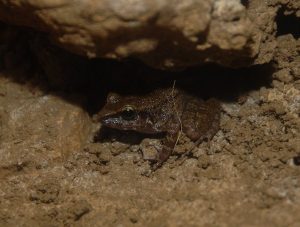 Project Palaka, Phase II – Platymantis insulatus ex situ program
Project Palaka, Phase II – Platymantis insulatus ex situ program
Norman Greenhawk, Project Palaka, Philippines
The target species for this grant is the Gigantes Forest Frog (Platymantis insulatus). This species occurs in the remote Gigantes Islands in the Philippines, in karst/limestone forests/caves which are threatened by logging and tourism. Although Critically Endangered, population dynamics of the Gigantes Forest Frog are unknown, owing to the remote location of the species and time it takes to get to Gigantes. There is a possibility that the species is extinct in the wild, and more fieldwork is required to properly assess the population. According to the Philippines Red List Assessment Workshop (May 2017), field surveys in 2014 found the species to be more abundant than previously thought, however, due to ongoing decline in the extent and quality of habitat, the population is suspected to be decreasing.
A team of six, including Project Palaka staff and students from the University of the Philippines, Los Baños (UPLB) will travel to Gigantes in October/November 2019 for one week to search for the species, conduct thorough population counts and habitat assessments, and collect individuals for housing at Project Palaka, on UPLB campus, in Laguna province. Project Palaka Phase I allowed for us to develop protocols for maintaining and breeding Platymantis species in captivity; these will be used to initiate a breeding program for Gigantes Forest Frogs. We will conduct another population survey in April/May 2020, and thereafter continue population monitoring every six months, on an October/November and April/May schedule. If the breeding program is successful, we anticipate releasing the first of the captive-bred offspring into the wild in the summer of 2020 (on a special trip). We then intend to keep breeding Gigantes Forest Frogs and conduct yearly releases in addition to twice-yearly monitoring.
For threat mitigation, we intend to better assess current threats to the species on the October/November trip this year. Assuming that logging is still the largest threat, we will work with reforestation groups in the Philippines to determine the feasibility of starting a reforestation/regeneration project on Gigantes. However, it is likely that such a project will not be started until at least 2021- the permitting and organization of such projects takes time in the Philippines.
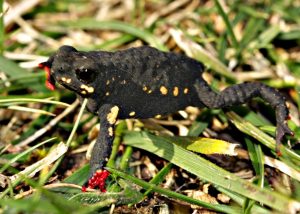 First steps towards the conservation of the Darwin’s Blackish Toad (Melanophryniscus nigricans)
First steps towards the conservation of the Darwin’s Blackish Toad (Melanophryniscus nigricans)
Igor Berkunsky, National University of the Centre of Buenos Aires Province, Argentina
The Darwin’s Blackish Toad (Melanophryniscus nigricans) is a threatened, recently described species, found highland grassland along the Tandilia Mountain System, in the south-east of the Province of Buenos Aires, Argentina. In the past, this species was considered as an unnamed taxon belonging to the Melanophryniscus stelzneri group, however since 2004, most researchers consider it a separated unnamed species.
Since the 1970s, the wild populations of this species have dramatically declined by more than seventy percent, with at least two well-known populations becoming extinct, and a third one is probably extinct. The remnant populations are facing a combination of threats which include habitat loss by forestry, invasive woody species, quarries, overgrazing and trampling by livestock, chytrid fungus, and desiccation caused by climate change.
In 2017, we started a conservation initiative aimed at identifying the main threats and exploring effective conservation actions to recover the populations of the Darwin’s Blackish Toad. Currently, only one protected area (the Sierra del Tigre Natural Reserve) is effective at guarding a wild population of this toad, and the managers of the reserve initiated a habitat restoration project aimed at providing additional habitat for the Darwin’s Blackish Toad. However, natural recolonization by the species is unlikely due to current fragmentation and the lack of corridors between remnant highland grassland habitats.
This project is aimed at increasing the area of occupancy of Darwin’s Blackish Toad. We will build ex situ breeding facilities at the Universidad Nacional del Centro de la Provincia de Buenos Aires campus and we will establish a survival colony. We also will include head-starting from eggs: we will collect some clutches from wild breeding sites and will maintain them in captivity until they reach juvenile or adult stage. All individuals produced in captivity will be translocated to restored and protected habitats in the Sierra del Tigre Natural Reserve and selected surrounding areas.
This project will result in the first effective conservation activities for the Darwin’s Blackish Toad, connecting the current populations, and increasing the species’ viability.
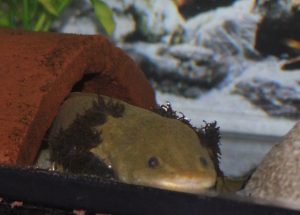 Start-up grant for the Lake Patzcuaro Salamander (Ambystoma dumerilii)
Start-up grant for the Lake Patzcuaro Salamander (Ambystoma dumerilii)
Margarita Ruiz Flores, Zacango Ecological Park – CEPANAF, Mexico
There are 659 known species of salamanders, and of these, seventeen species are endemic to Mexico and four of them are kept in a neotenic state (the retention of some juvenile traits). The Lake Patzcuaro Salamander (Ambystoma dumerilii) is a commercially-harvested species, with catches registered in tons from 1987 to 1991.
In the Purepecha culture, this species, which is known as the Achoque, is part of traditional medicine and is used by local people as a food source. Due to the contamination of Lake Pátzcuaro and the overexploitation of the species, by 2011 the Achoque was partially extinct from the lake. In 2019, the Michoacán University of San Nicolás de Hidalgo (UMSNH), conducted an investigation on the possible extinction of the Achoque in Lake Pátzcuaro, discovering a considerably large population of Achoque in situ. This discovery gives us a window of opportunity to save the species.
A considerable number of local people in Pátzcuaro, Michoacán, is engaged in fishing, and it has been identified that while dragging their fishing nets in the lake, Achoque eggs are collected, which are not returned to the lake, causing them to die. The project aims to save at least fifty percent of the eggs which are collected accidentally during the months of oviposition. All eggs that are recovered will be hatched in captivity and the specimens will be released after completing the development of their four limbs (feet and hands).
The species is listed in the IUCN Red List of Threatened Species as Critically Endangered, is listed as CITES Appendix II, and locally is listed as NOM-059- SEMARNAT-2010: (Pr) Subject to Special Protection by the Secretariat of Environment and Natural Resources in Mexico. It is important for conservation work to be undertaken with the population to attempt to recovery this species in its natural habitat. The project addresses one of the main causes of extinction: by-catch of eggs.
We propose to create a technical manual for the ex situ breeding and rearing of Achoque larvae, which allows us to standardize an adequate methodology for the development and subsequent release of the Axolotls; reference bibliography for intensive periods of wildlife management (farms or facilities that manage wildlife in a confined form, outside of their natural habitat, for the purpose of controlled reproduction of species or populations for commercial use, without the purpose of recovering species or populations for their subsequent reintegration into the wild); and units of management for wildlife conservation established.
We will recover the eggs that collected incidentally in fishing nets, transfer them to the laboratory where they can be hatching and reared, and then reincorporate the hatched specimens to Lake Pátzcuaro. We also hope to work with local fishermen to mitigate the incidental exploitation of the species.







